Papers by Martine Buatier

Ten sites were drilled in the eastern flank of the Juan de Fuca Ridge (North East Pacific) along ... more Ten sites were drilled in the eastern flank of the Juan de Fuca Ridge (North East Pacific) along a 100 km-long east-west transect during Leg ODP 168. This study focuses on the mineralogical and chemical study of sediments that overly basaltic basement through which seawater circulates. Silicate authigenesis was observed in the sediment layer just above basement at sites located more than 30 km from the ridge axis. This sediment alteration is particularly abundant at ODP Sites 1031 and 1029 where authigenic formation of Fe-Mg rich smectite and zeolite and the dissolution of biogenic calcite are observed. Comparison of the distribution of the alteration in the basal sediment collected along this transect suggests that diffusional transport of aqueous solutes from the basement into the overlying sediment cannot produce the mineralogical and chemical changes in the basal sediments at Sites 1031 located on a basement topographic high, and at Site 1029 located at about 50 km from the ridge axis on a buried basement area. Vertical advection of basement fluid though the sediment section is required to produce this alteration. These processes are still active at Site 1031, based on systematic variations in pore-water profiles and temperatures obtained from stable isotopic data on calcium carbonates and the nature of authigenic minerals. At Site 1029, there is no present-day advection of basement fluids though the sediment section, suggesting that this is a relic site for fluid flow.
Bulletin De La Societe Geologique De France, 1995

Proceedings of the Ocean Drilling Program, 1994
Oxygen and carbon isotope measurements on authigenic carbonates and silicates from Sites 856, 857... more Oxygen and carbon isotope measurements on authigenic carbonates and silicates from Sites 856, 857, and 858, drilled during Ocean Drilling Program Leg 139 at Middle Valley, Juan de Fuca Ridge, a sedimented seafloor spreading ridge, provide a record of present and past convective fluid circulation and high-temperature gradients associated with hydrothermal alteration and the deposition of massive sulfides. Oxygen isotope compositions of authigenic carbonates from the active hydrothermal field at Site 858 show vertical thermal gradients of 2.2°C/m in distal holes (Holes 858A and 858C) and up to 10°C/m at the central vent areas (Hole 858D). The higher thermal gradient is consistent with oxygen isotope data for Mg-rich authigenic clays and quartz, which yield isotope fractionation temperatures of approximately 265°C at 32 mbsf in Hole 858B. Extrapolation of this latter gradient to greater depths indicates temperatures of approximately 400°C at depths of 4(M•5 mbsf in the sedimentary sequence, approaching values that are sufficiently high to generate ore-forming fluids at these shallow depths. Furthermore, the calculated thermal gradients from the active vent area are similar to paleo-geothermal gradients recorded in the oxygen isotopic composition of carbonates from the relic hydrothermal field at Site 856, which are higher than the modern measured geothermal gradient. Carbon and oxygen isotope data of shallow carbonates at the active hydrothermal field are consistent with methane oxidation and, together with the presence of dolomite and Mg pore-water profiles, provide evidence for the advection of cold, oxidizing surface waters at shallow depths. From about 5 mbsf to the base of the cored section at Site 858 and throughout the hydrothermal reservoir at Site 857, the carbonate cement and nodules with δ 13 C values between-lO‰ and-25‰ reflect sulfate reduction and/or thermal decomposition of organic matter. The results of this isotope study, combined with pore-water and sediment geochemistry, delineate a system of large-scale convective hydrothermal circulation through the sedimentary sequence. In addition, smaller-scale fluid advection occurs in the shallowest part of the section. The oxygen isotope data imply an altered isotopic composition for the circulating fluid indicating that the reaction rates or fluid/rock interactions must be high relative to the fluid flux rates.
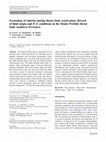
Contributions to Mineralogy and Petrology, Jan 17, 2012
The chemical and isotopic compositions of clay minerals such as illite and chlorite are commonly ... more The chemical and isotopic compositions of clay minerals such as illite and chlorite are commonly used to quantify diagenetic and low-grade metamorphic conditions, an approach that is also used in the present study of the Monte Perdido thrust fault from the South Pyrenean fold-and-thrust belt. The Monte Perdido thrust fault is a shallow thrust juxtaposing upper Cretaceous-Paleocene platform carbonates and Lower Eocene marls and turbidites from the Jaca basin. The core zone of the fault, about 6 m thick, consists of intensely deformed clay-bearing rocks bounded by major shear surfaces. Illite and chlorite are the main hydrous minerals in the fault zone. Illite is oriented along cleavage planes while chlorite formed along shear veins (\50 lm in thickness). Authigenic chlorite provides essential information about the origin of fluids and their temperature. d 18 O and dD values of newly formed chlorite support equilibration with sedimentary interstitial water, directly derived from the local hanging wall and footwall during deformation. Given the absence of largescale fluid flow, the mineralization observed in the thrust faults records the P-T conditions of thrust activity. Temperatures of chlorite formation of about 240°C are obtained via two independent methods: chlorite compositional thermometers and oxygen isotope fractionation between cogenetic chlorite and quartz. Burial depth conditions of 7 km are determined for the Monte Perdido thrust reactivation, coupling calculated temperature and fluid inclusion isochores. The present study demonstrates that both isotopic and thermodynamic methods applied to clay minerals formed in thrust fault are useful to help constrain diagenetic and low-grade metamorphic conditions.

<p>The diagenesis of biogenic silica is arguably one of the most si... more <p>The diagenesis of biogenic silica is arguably one of the most significant early diagenetic processes in the shallow subseafloor and can also have profound implication for the routing of magma in rift basins. The transformation of glass-like amorphous silica (opal-A) in diatoms and radiolarians into crystalline forms (opal-CT) converts soft and watery biogenic oozes into harder sedimentary rocks. The silica diagenetic front is extensive (km-scale) forming prominent seismic reflectors, causes regional-scale differential compaction, subsidence, and the expulsion of pore fluids. Most importantly, it corresponds to changes in sediment rheology from ductile oozes to brittle, fracture-prone and more permeable sedimentary rocks. The relationships between silica diagenesis and subseafloor magmatism have been investigated by Expedition 385 of the Integrated Ocean Discovery Program (IODP) in the off-axis region Guaymas Basin (GB) of the Gulf of California at the neighboring Sites U1545 and U1546, the latter including a  ~70 m-thick sill intrusion, and at Site U1547, where the top of a massive sill was recovered at shallower depths. The lithostratigraphic and mineralogic analyses of the cores recovered by the expedition combined with interstitial water geochemistry and physical properties unveil a new and somewhat unexpected picture of the GB’s subseafloor environment. The first discovery is that despite the super-fast sedimentation/burial (up to 1m/kyr) and the very high geothermal gradients, the transformation of opal-A to opal-CT occurs at ~75 ºC or higher <em>in situ </em>temperatures which is much hotter (and deeper) than expected based on previous deep-sea core studies, outcrop studies, laboratory experiments or calculated by models. We hypothesize that the apparent ‘sluggishness’ of silica transformation is the result of the current kinetic model not being able to predict this transformation when burial rates are much faster than typical biogenic sediments in open ocean conditions for which they were originally created. The second important finding relates the Opal CT-zone with magma intrusions.  The massive sill  at Site U1546 splits the opal-CT zone, though the latter has identical characteristics (e.g. total thickness, gradual increase in silica crystallization with depth) as the opal-CT zone at the nearby Site U1545, located just outside the extent of the sill. Moreover, the sill intrusion is much shallower at Site U1547 where the opal-CT zone is also shallower due to the higher geothermal gradient (~510 Cº/km as opposed to ~100 ºC/km at Site U1546). Not only these observations suggest that the sill formation postdates the silica phase change, but also that this diagenetic interface controls the way magma moves in the GB subseafloor whereby the opal-A/opal-CT transition zone acts as major physical anisotropy in the sedimentary column to reroute magma from vertical to lateral movement. In conclusion, this study greatly expands the range of depths/temperatures at which amorphous silica can persists in the subseafloor and establishes fascinating connections between seemingly disconnected processes in the natural world: surface water biological productivity and crustal architecture of a newborn ocean. </p>
Guaymas Basin Tectonics and Biosphere, 2021
Contents 1 Summary 11 Background and objectives 13 Operations 18 Lithostratigraphy 31 Igneous pet... more Contents 1 Summary 11 Background and objectives 13 Operations 18 Lithostratigraphy 31 Igneous petrology and alteration 46 Structural geology 49 Biostratigraphy 52 Paleomagnetism 62 Inorganic geochemistry 69 Organic geochemistry 79 Microbiology 84 Petrophysics 96 References
Guaymas Basin Tectonics and Biosphere, 2021
Contents 1 Introduction 7 Core handling and analysis 9 Lithostratigraphy 20 Igneous petrology and... more Contents 1 Introduction 7 Core handling and analysis 9 Lithostratigraphy 20 Igneous petrology and alteration 29 Structural geology 36 Biostratigraphy 42 Paleomagnetism 46 Inorganic geochemistry 52 Organic geochemistry 60 Microbiology 74 Petrophysics 100 References
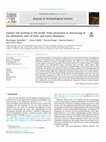
Journal of Archaeological Science, 2018
Since the Early Neolithic, salt has played an important role in the social and economic developme... more Since the Early Neolithic, salt has played an important role in the social and economic development of populations. Consequently, the study and comprehension of salt management strategies have become a significant component of current archaeological research. This study is part of an interdisciplinary research program consisting of excavations and detailed analyses on two Early Neolithic salt working sites situated in the sub-Carpathian region of Romania, Lunca and Ţ olici (county Neamt¸). These remarkably well-preserved sites are characterised by stratified deposits several meters thick. Detailed stratigraphic descriptions were followed by optical microscopy analysis (soil micromorphology) and scanning electron microscopy (SEM) coupled with geochemical analysis (EDS). The aim of these analyses was to identify specific sedimentary, petrographic and chemical characteristics that could be linked to salt working process. The results enable us to describe the main site formation process over time and to detect chemical components of edible salt (Na and Cl) in Early Neolithic ashes. These new data consolidate previous interpretations of the operating procedures implemented from the Early Neolithic to the Bronze Age. Two techniques appear to have been preferentially adopted: pouring natural brine onto combustion structures during the Early Neolithic and evaporation in specific ceramic containers from the Chalcolithic onwards.

Tectonophysics, 2018
The Pyrenees belt features well exposed deformation structures that make it ideally suited to stu... more The Pyrenees belt features well exposed deformation structures that make it ideally suited to study thrust faults. In this paper, we present the first 40 Ar/ 39 Ar age of the Pic de Port Vieux thrust (PPVT) located in the southwestern part of the Pyrenean Axial Zone. The PPVT is a secondary thrust related to the major Gavarnie thrust (GT) with a footwall comprising Upper Cretaceous limestones, and a hanging wall made of Lower-Triassic pelites and sandstones. A vertical transect in the fault hanging wall was investigated to characterize the deformation mechanism and to date the thrust activity by using 40 Ar/ 39 Ar step-heating technique on muscovite. Petrographic observations confirm that pressure solution and recrystallization/dissolution processes in presence of fluids are the main mechanisms that controlled the chemical/textural changes in the fault core zone. Three groups of muscovite are identified in the fault zone i.e. detrital, diagenetic and newly-formed muscovites. The detrital and diagenetic muscovites are mainly present in the damage zone, while the newly-formed muscovite is abundant in the core zone and is synkinematic to the fault activity. The fractions 50-16 μm, 16-2 μm, 2-0.5 μm, < 0.5 μm and the bulk of two samples from the core and damage zones were encapsulated and dated using the 40 Ar/ 39 Ar technique. All size-fractions of the core zone sample have younger ages compared to ones from the damage zone and the ages decrease with grain-size reduction. This indicates the strong effect of deformation in the core zone that enhanced the recrystallization of younger muscovite. The finest fraction (< 0.5 µm) of the core zone sample has a plateau-like spectrum with a total gas age of 36.9 ± 0.2 Ma. This age is interpreted as the oldest age possible for the activity of the PPVT during the late Eocene (Priabonian) that coincides with the activity of the GT.
European Journal of Mineralogy, 2000
Nacrite, a two-layer polytype of kaolin (space group Cc) generally formed at high temperature, wa... more Nacrite, a two-layer polytype of kaolin (space group Cc) generally formed at high temperature, was found in the Lodève Basin, France. It occurs in dolomite cavities in the Cambrian basement of the Permian basin, as authigenic, euhedral, up to millimetre-sized crystals, ...
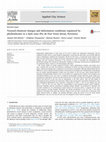
Applied Clay Science, 2017
Synkinematic phyllosilicates in fault zones can be used to deduce the deformation mechanisms and ... more Synkinematic phyllosilicates in fault zones can be used to deduce the deformation mechanisms and the conditions of fault activity, as their chemical composition, crystal structure and texture can record the different stages of deformation and fluid-rock interactions. The Pic de Port Vieux, a second-order thrust related to the major Gavarnie thrust in the southern central part of the Pyrenees Axial Zone, juxtaposes Triassic pelites of the hanging wall and Cretaceous limestones of the footwall. In order to investigate the mineralogical and geochemical changes and constrain the deformation conditions of thrusting, characterization of phyllosilicates was performed along a transect in the fault hanging wall pelites. The Triassic pelites are mainly composed of quartz, calcite, phyllosilicates (chlorite and K-white mica) and ± hematite. The core fault zone thickness is estimated to be about one meter of intensively foliated green pelites, whereas the damage zone is composed of several meters of red pelites. XRD data demonstrated that the difference in color is related to hematite which is only present in the damage zone. Phyllosilicates of the damage zone are mainly inherited/diagenetic K-white mica and chlorite. In the core zone, newly formed chlorite is abundant and preferentially located in veins. It is enriched in Fe compared to the chlorite of the red pelites. The well-defined foliation in the core zone is overlaid by preferentially oriented muscovite grains which have homogeneous compositions, with less Na and relatively more Fe than mica from the red pelites. Newly formed chlorite and muscovite in the core zone are synkinematic to the fault activity. They are both related to deformation processes and fluid rock interactions. Kübler index measurements and chlorite thermometry show that synkinematic phyllosilicates have registered a temperature of 270°C ± 23°C for the damage zone and 285°C ± 28°C for the core zone which are corresponding to lower-anchizone/epizone grade conditions. Numerical modelling with the geochemical modelling program PhreeqC was performed to determine the favorable conditions for the mineralogical change between red and green pelites. It suggests that the main critical parameter favoring hematite dissolution and chlorite precipitation in the core zone, is the redox conditions. According to the model, the chemical changes in the core zone occurred due to interactions with highly reductive fluids. In addition, the hematite dissolution maybe the source of iron for newly formed phyllosilicates in the core zone that are more iron rich compared to those from the red pelites.
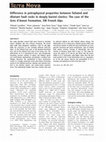
Terra Nova, 2014
This study describes normal fault zones formed in foreland arkosic turbidites (the Gr es d'Annot ... more This study describes normal fault zones formed in foreland arkosic turbidites (the Gr es d'Annot Formation, SW French Alps) under deep diagenesis conditions (~200°C) and highlights the occurrence of two markedly different fault-rock types: (1) the foliated fault rocks of the Mouti ere-Restefond area; and (2) the dilatant fault rocks of the Estrop area. The deformation of (1) is dominated by intra-and transgranular fracturing, pressure solution of quartz and feldspar grains and syn-kinematic phyllosilicate precipitation resulting from feldspar alteration. The combination of these mechanisms results in a strongly anisotropic strain with intense shortening normal to the foliation (pressure solution) and extension parallel to the foliation (quartz-and calcite-sealed extension veins). This deformation implies local mass transfer that may be achieved without (or with limited) volume change. The deformation of (2) is expressed as dilatant quartz-sealed veins and breccia textures in which the main mechanisms are transgranular fracturing and quartz precipitation. Type (2) implies fault volume increase, isotropy of deformation and mass transfer at distances larger than in type (1). This study discusses the origins of (1) and (2) and shows that the permeability of (1) is anisotropic, with higher values than the host rocks parallel to the Y main deformation axis (i.e. perpendicular to the slip vector), whereas the permeability of (2) is isotropic and equivalent to that of the host rocks.

Geophysical Research Letters, 2013
Phyllosilicate content and related permeability of fault zones form primary controls on hydraulic... more Phyllosilicate content and related permeability of fault zones form primary controls on hydraulic and mechanical behavior of the brittle crust. Hence, understanding and predicting the localization of these ubiquitous minerals is a major issue for fundamental and applied geosciences. We describe normal fault zones cutting a foreland arkosic turbiditic formation suffering high-T diagenesis and formed under conditions (~200°C) typical of deeply buried reservoirs and common within the seismogenic interval. Microstructural analyses show a large proportion of phyllosilicates (up to 34%) in the fault rock, derived from near-complete feldspar alteration and disaggregation during deformation. This study shows that even faults with offsets (~20 cm) much lower than bed thickness can have such large feldspar-to-phyllosilicate transformation ratios, implying that the origin of the phyllosilicates is purely transformation related. These results imply that the potential sealing capacity and strength of faults could be predicted from the host rock feldspar content. Where sealing capacity and fault strength can be related to phyllosilicate content, these properties can then also be inferred from the predicted phyllosilicate content: this opens up new horizons concerning the hydraulic and the mechanical behavior of the upper crust.
Geological Society, London, Special Publications, 1998
Abstract In the frontal part of the south Pyrenean Eocene thrust-fault system, syn-kinematic flui... more Abstract In the frontal part of the south Pyrenean Eocene thrust-fault system, syn-kinematic fluid flow during the early compressional deformation of the foreland basin marls is evidenced macroscopically by the abundance of calcite shear veins within the thrust-fault ...
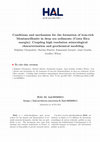
Geochimica et Cosmochimica Acta, 2011
Iron-rich smectite is commonly described in the diagenetic fraction of deep-sea sediment, as mill... more Iron-rich smectite is commonly described in the diagenetic fraction of deep-sea sediment, as millimeter to centimeter aggregates dispersed in the sediment, or as a coating on sedimentary particles or nodules. This study examines several factors to elucidate formation mechanisms of a particular iron-rich smectite and its potential transformation to glauconite. The study combines a detailed mineralogical investigation on natural samples and a chemical modeling approach to assess mineralogical reactions and pathways. Transmission electron microscopy (TEM) observations and analytical electron microscopy (TEM-AEM) analyses were conducted on microtomed samples of millimeter-to centimeter-long green grains. These grains are widespread in pelagic calcareous sediment from the Costa Rica margin. They are composed of pyrites that are partially dissolved and are surrounded by amorphous or very poorly crystallized iron-rich particles. Iron-rich montmorillonite grows from an amorphous precursor and its formation requires the input of Si, O, Mg, K, Na and Ca; our results suggest that these inputs are supported by the dissolution of sedimentary phases such as volcanic glasses, siliceous fossils and silicates. Thermodynamic modeling of fluid-sediment interactions was conducted with the geochemical computer code PhreeqC, using mineralogical and pore fluid compositions from sediment samples and calculated estimates for thermodynamic constants of smectites that are not maintained by the computer code. Simulations confirm the possibility that the green grains are the product of pyrite alteration by seawater under oxidizing conditions. The extent of smectite production is controlled by the kinetics of pyrite dissolution and fluid migration. The absence of aluminum in the Costa Rica margin system explains the formation of an iron-rich montmorillonite instead of glauconite, whereas the presence of calcite that buffers the system explains the formation of an iron-rich montmorillonite instead of iron oxides.
International Ocean Discovery Program Preliminary Report, 2020
strategies (for example, the advanced piston corer [APC] and halflength APC systems) and numerous... more strategies (for example, the advanced piston corer [APC] and halflength APC systems) and numerous analytical innovations have greatly improved sample recovery and scientific yield, particularly in the areas of organic geochemistry and microbiology. For example, microbial genomics did not exist 40 y ago. However, these technical refinements do not change the fact that Expedition 385 will in many respects build on the foundations laid by Leg 64 for understanding Guaymas Basin, regardless of whether adjustments are required in the near future.
Logging data are measurements of physical properties of the formation surrounding a borehole, acq... more Logging data are measurements of physical properties of the formation surrounding a borehole, acquired in situ after completion of coring (wireline logging) or during drilling (Logging-While-Drilling, LWD). The range of data (resistivity, gamma radiation, velocity, density, borehole images,…) in any hole depends on the scientific objectives and operational constraints.











Uploads
Papers by Martine Buatier